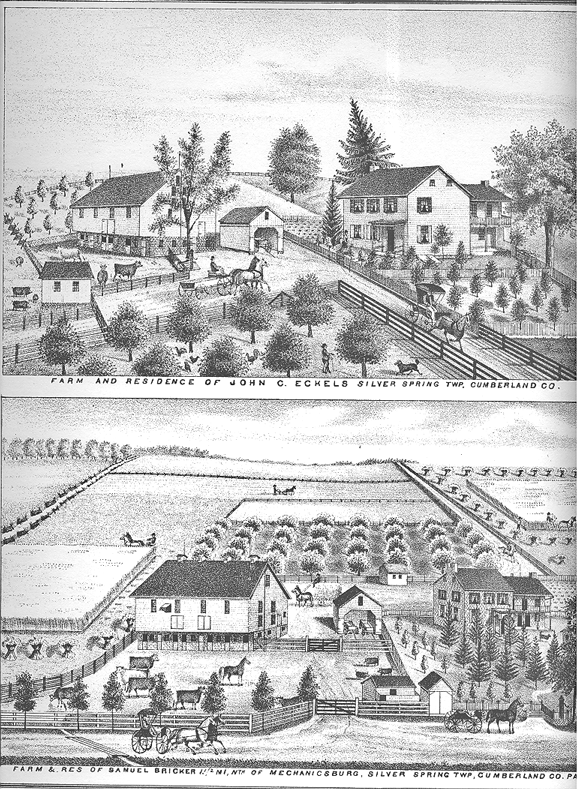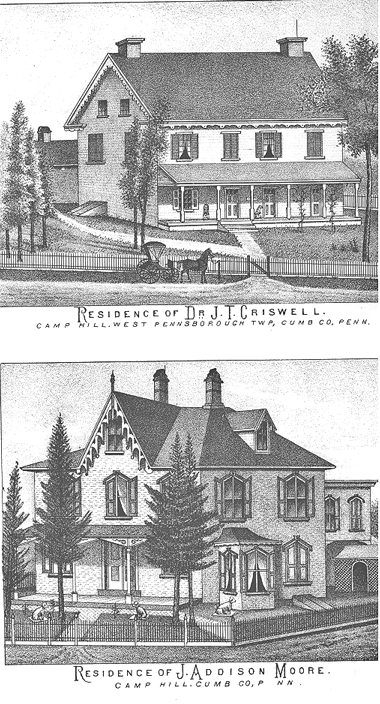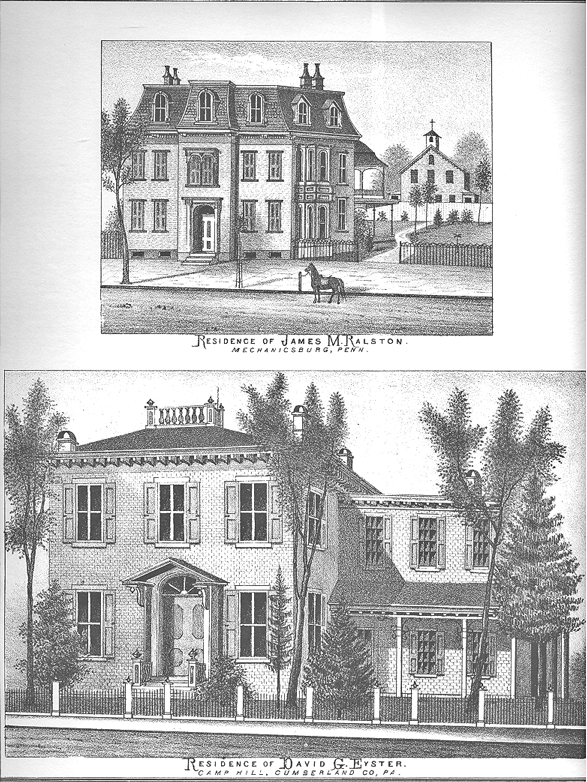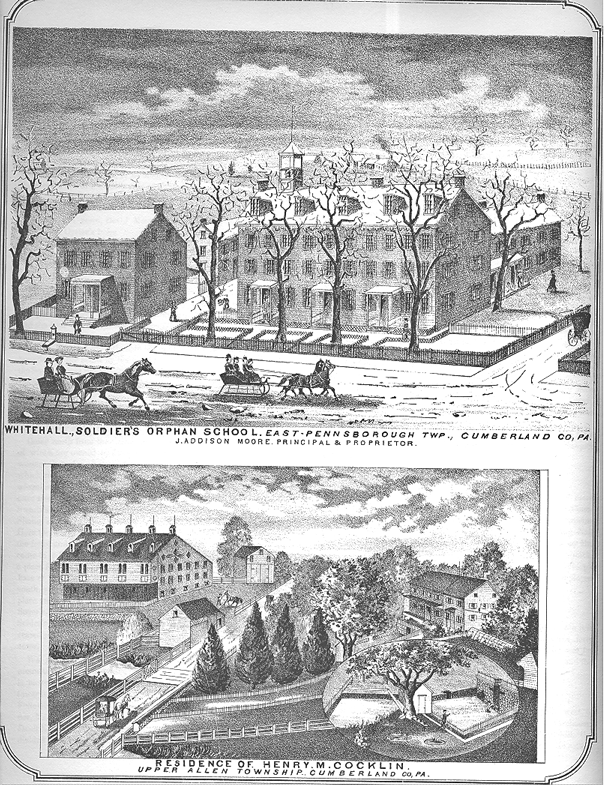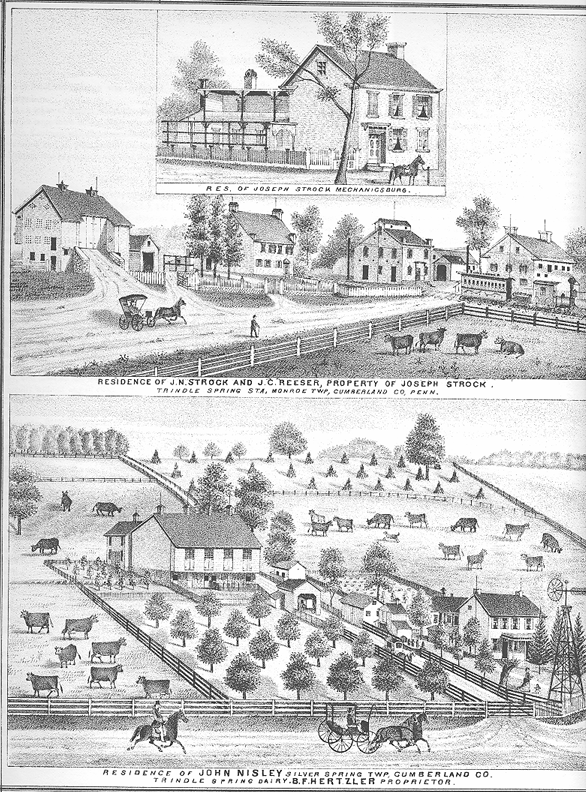History of the Township and Boroughs of Cumberland. County.
LOWER ALLEN TOWNSHIP.
BY. J. C. NESBIT, ESQ
INDIANS.
That the early settlers in the northern part of the present township of Lower Allen did not find the territory quite uninhabited, is rendered probable by the traces of Indian towns which are still visible. Three extensive villages must have existed about that time in this vicinity ; one a little north of the mouth of the Yellow Breeches creek ; another a short distance north f the house now occupied by William Kohler, and the other on or near Rich Hill, in the neighborhood of Milltown or Eberly's mills. The first two were in close proximity to each other, but this was owing, doubtless, to their dependence upon the river for their supply of fish. It is not certain that these villages were inhabited at the same time. At Rich Hill was one of their burial places, the graves of which were said to have been easily distinguishable in the early days of some of the present inhabitants, and Indian relics are not unfrequently there picked up. Mr. John Black, one of the early settlers, used to relate that he saw, on a certain occasion, two hundred Indian warrioro, traveling down the Braddock road, one following the other with such exactness that it was almost impossible to detect the footmarks of more than one man in the snow which then covered the ground, after they had passed in Indian file. There is no evidence that any interruption ever took place in the peaceful relations of these Indians to the earliest settlers.
EARLY SETTLERS.
We are in possession of no deeds or other documents which indicate any earlier occupation of lands than the year 1739. Alexander Frazer bought in that year of the Penn heirs, a tract of two hundred acres on which the present mills and a part of the town of Lisburn are situated. In 1740 Peter Chartier bought of John Howard and Richard Penn six hundred acres, bounded on the east by the river, on the south by the Yellow Breeches, on the north by Washington Kister's and George W. Mumper's lands, and on the west by property belonging to Flickinger's heirs, and Andrew Ross. In 1773 William Black, from Scotland, purchased the property now possessed by the Flickinger heirs, and John Mish, a native of Wirtemburg, in 1770, purchased 283 acres where Henry Zimmerman lives, and built on the bank of the Yellow Breeches creek a house and a tannery. This tannery was an object of much interest in those times, it being the first in this region. During the Revolution it was the only place for many miles at which' small parcels f leather could be obtained. About the same time, John Wilson purchased 200 acres along the river, now owned by the heirs of Wm. Mateer, and extending from the Feeman farm to the McCormick farm. The land lying between this tract and the bridge at Harrisburg was bought by Moses Wallis about 1768-70, and from him passed successively through the hands of Alexander and James Mills, and is now owned by the McCormicks. On this property extensive quarries f limestone have since been opened. John Fleck who died at the age of 65, in the year 1795, was in his day the largest land-owner in this end of the county, and must have settled there at an early period.
The great-grandfather of Wm. R. Gorgas came from Holland near the commencement f the last century, and settled at Germantown or Philadelphia. Solomon, his father, was born at Ephrata, Lancaster co., 1764, and settled in this valley in 1791. Wm. R Gorgas was horn May 8, 1800, and owns the farm on which the original settlement was made. He was a Representative in the Assembly from 1836 to '39, and a State Senator from 1842 to 1844 inclusive. He has taken an interest in all public measures of importance, and the results of his efforts are seen in the valuable improvements and institutions which have sprung up around him.
GENERAL DESCRIPTION.
Lower Allen was set off as a distinct township in 1850. It is bounded on the north by Hampden, Shiremanstown and East Pennsborough, on the east by the Susquehanna, on the south by the Yellow Breeches creek and on the west by Upper Allen. The agricultural is the predominant interest ; the land is principally limestone, though sandstone and slate are found in narrow belts. Large quantities of iron ore were formerly taken from the Gorgas mines, and there still remain enough for profitable operations in them, but for some years the works on them have been suspended.
LISBURN.
The oldest village in the township is unquestionably Lisburn, in the southern corner, in a loop of the Yellow Breeches creek. It has fifty-six buildings of all kinds, and 216 inhabitants. The houses of the original settlers have all disappeared and very little of their history has been preserved. The mills, the old forge and a portion of the town are all located on a tract of land which was conveyed by the heirs of Wm. Penn to Alexander Frazer, in 1739. The names New Lisburn, Lisborn and Lisbon are found in deeds and other papers as far back as 1765. A draft of the original plot of the town is known to exist, and is said to present an alley parallel with, and 190 feet from, the center of the present street, and extending the entire length of the town, on the south side. A corresponding one extended on the north side. Alleys now run at right angles with the main street and these alleys, and terminate with the latter. The deeds of some lots are dated as far back as 1765, and they are numbered so as to correspond with the plot above mentioned. One of these is " From Ralph Whitsett to William Bennett for a lot where Jacob Flickemell has built his brick house." This was probably the first brick house in the township. Tradition asserts that a spinster whose name was Elizabeth Burns presided at an early period over a cake and beer establishment, and that the " young bloods " of the vicinity spoke of a visit to her store as a trip to " Liz Burns," from which grew the name of the village. To many this origin of the name is unsatisfactory, and
(200.)
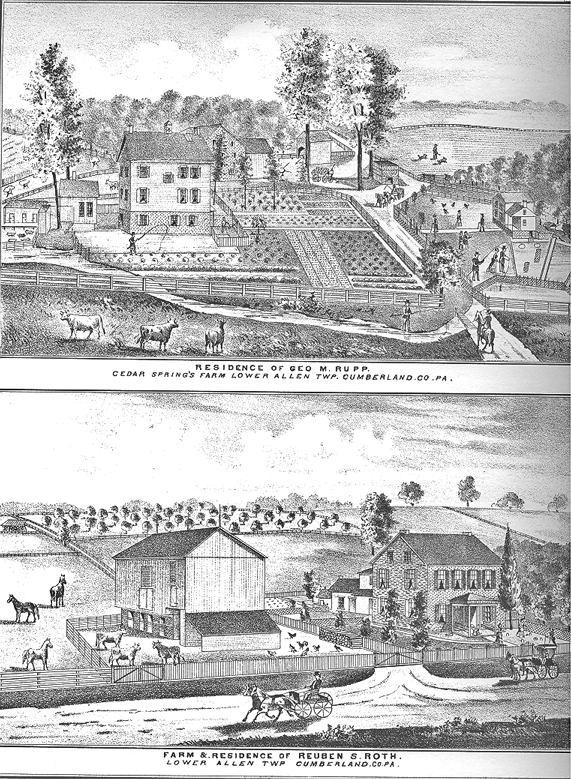
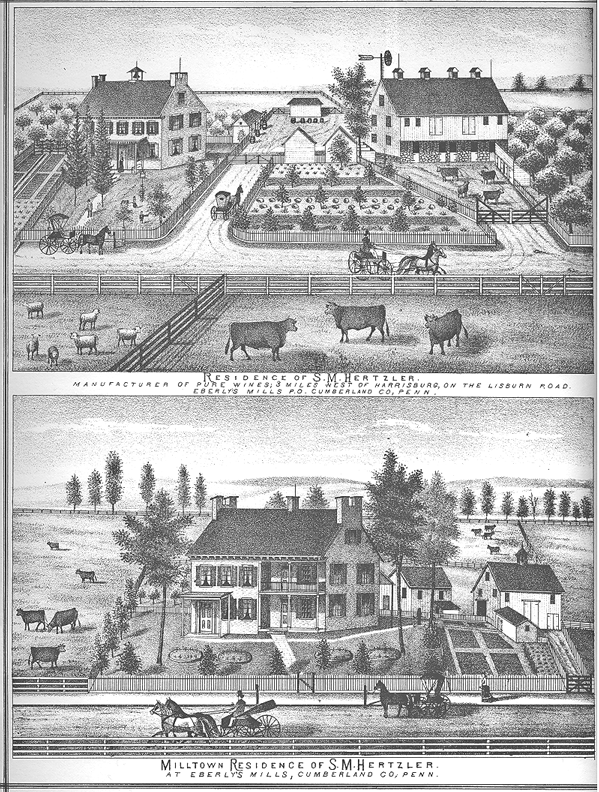
HISTORY OF CUMBERLAND COUNTY, PENNSYLVANIA.201
they tell us of a place bearing the same name in Ireland, from which some of the early settlers may have emigrated. A fair is known to have been held every year in the village, to which the people resorted in the fashion of the old country. The trades usual to country villages were carried on, but in the year 1820, a Mr. Young introduced a nail cutting machine which is thought to have been the first of the kind in the county. The Lisburn Forge near the present mill, was built in 1783. The hotels of the place have been kept, within the present century, by J. Flickemell, Wm. Naylor, Peter McKam and J. G. Fleck. Among the prominent men connected with the history of the town are remembered Alexander Frazer, the original proprietor, Wm. Bennett, Ralph Whitsett, James Galbraith, Adam Brenizer, Robert Thornberg, Michael Hart, Benjamin Anderson, Andrew Mateer, Peter McKam, J. Snyder and John McCue. Among the mechanics have been J. Wilson and E. Kauffman, blacksmiths ; F. C. Smith and J. L. Finney, shoemakers ; C. Scherich, W. Kilmore and U. A. Floyd, cabinet makers and carpenters ; F. G. Goodyear, tin and sheet-iron worker ; S. C. Pipher, saddler and harness maker; H. C. Orth, tailor ; R. P. Hull, clock and watch repairer, and S. A. Gehr, wagon maker. Bitner & Co. and J. S. Starr are merchants, and Dr. J. W. Trimmer has acquired an extensive practice as a physiciau. Among the physicians of a former day have been Drs. Thomas Goforth, Webster Lewis, La-rue Lemar (40 years), J. M. Stickel, E Warren and W. J. Boydston. In 1876 a company was formed for the purpose of building a Town Hall for public exhibitions, concerts, lectures, &c., and the result has been a large structure, the upper story of which is used for such a hall and the lower is used for a store and dwelling.
MILLTOWN OR EBERLY'S MILLS.
This village is located on Cedar Run, one eighth f a mile from its confluence with the Yellow Breeches. It has 83 inhabitants, and is on a tract of land originally owned by a Mr. Thompson. It has fifteen houses one of which is of brick, two f stone, two rough cast and the remainder are of wood. It has one church, one store, one blacksmith shop, one shoe shop and one machine shop. A merchant and grist mill was built in 1817 by George Fahnestock, but has since been owned by Price & Emmert, Fleck, Eberly, Beetem, Leonard & May and Dillinger the present proprietors. It is on Cedar Run, has four sets of stones, once had an engine, which has, however, been abandoned, and has once been thoroughly remodeled. Near it is an old mill which must have been built in the last century, but has been converted into a dwelling house. What was once a clover mill has been remodeled and fitted up as a machine shop. The present proprietor, Daniel Drawbaugh, some years since formed a stock company for the manufacture of measuring faucets and rotary pumps, and for a while the machinery was used for the purposes f this company, but finally the faucet machinery was removed to Mechanicsburg and the works were much reduced. They are now applied, under the care of Mr. Drawbaugh, to the manufacture f his Patent Electric Clock which is a marvel of ingenuity, and promises to supercede all other clocks. They are said to be run by a turbine wheel of fifteen horse power, and to be worth not less than $7000.
OTHER MILLS AND MANUFACTORIES.
A quarter of a mile east of Milltown, on the creek, is a stone mill, built by Henry Weber in 1817, but now in possession of Messrs. Etter Shanklin, and running four sets of stones by a Johnson wheel of 45 horse power. The Lisburn Mills were probably first constructed as early as in 1751, for in that year 21 acres of Mr. Frazer's original tract were set apart for mill purposes and a log mill was erected thereon. It is not known whether it was a grist or a saw mill, or whether both were not started at the same time. The property belonged to a son of the original proprietor, and continued in his possession until 1765, when it was sold and passed through a number of hands until it reached the present owner, Jacob S. Kunkle. It bas been remodeled a number of times, now runs four sets f stones with a Johnson wheel of 50 horse power and grinds annually 22,500 bushels of grain. Among the mills here connected together were once a fulling mill, which was demolished about 1845, and a clover mill originally(1852) designed for the manufacture of shingles, but since used for making gun barrels, matches, and sawed shingles, and at present for cleaning clover seed. Connected with it is a lathe, circular saw, and machinery for manufacturing a spiral check spring or an Elliptic Spring Support patented by C. Schenck, Esq., of this place. The saw mill and the clover mill are said to do a large business. On the Yellow Breeches creek, near New Cumberland, is Garver's Mill, built in 1826 by Jacob Haldeman who held possession f it until 1863, when it passed into the hands of Andrew Ross. In 1876 it came into the possession of its present owner, Christian Garver. It is built of limestone, four stories high, with five sets of stones and two turbine wheels of 48 horse power, and packs one barrel of flour per minute. Zinn's Woolen Factory, on the same creek, two miles northeast of Lisburn, was erected in 1857 by Moses Bowers, on the site of an old grist, oil and saw mill. It is a wooden structure, two and a half stories high, with a carder and picking machine, two roll and three wool cards, two breakers, a condenser, a spinning jack, three looms for fancy and one for flannel goods, a blanket loom, fulling stock, knapper, ender bar and shearing machine. It is now leased and operated by .1. P. Keefer. Liberty Forge. on the same creek, one mile north of Lisburn, was built at some time in the last century, but in 1847 came into the possession of Hon. H. G. Moser, who set in it four fire places and for a number of years carried on a profitable business. It has since been conducted by Mr. J. H. Boyer, who remodeled it and was for some time equally successful, but in the general decline of the iron business he has seen fit to retire and allow the works to remain idle.
CHURCHES.
There are three churches in the township ; the Mennotnite, the Lisburn Union, and the Milltown Bethel. A notice f the first, from materials communicated by Elder Moses Miller has already been given on p. 129. We have no account f a house of worship in Lisburn until 1814, when the citizens associated together " to purchase a house and lot for a school house and a house for public worship for religious societies f every Christian denomination, who shall subscribe one-tenth of the money appropriated for such a purpose." For one hundred and thirty pounds the property was secured to regular trustees, but we have no account of any religious services there for the first ten years. For two years, at least, very efficient services were held half f the time under Rev. J. Winebrenner, the other half being given at Mateer's school house. In 1829, a new building exclusively for religious services was erected which was remodeled and cased with brick in 1851. There has been no time for the last quarter of a century in which the community has not been supplied with religious services by different denominations.
202 - HISTORY OF CUMBERLAND COUNTY, PENNSYLVANIA.
The Milltown church was erected- in 1842, upon an eminence a short distance northeast of Milltown. It is a frame building, 32 by 28 feet and one-story high. It belongs to the Church of God, has sometimes had a numerous congregation, and is now under the pastoral charge f Rev. Alexander Wiley. There are three church edifices within a few miles belonging to the same denomination, and one is in process of construction in Lisburn f brick, and thirty-five by forty-five feet in extent.
CEMETERIES.
Besides the Indian graveyard on Rich Hill near Milltown, to which, reference has been made, there are a number of public and private cemeteries. Some f these must have been ancient, but no records remain of their origin. The one at Lisburn is probably the place where the early settlers in this part deposited their dead. It is on the southeastern slope of the high grounds near the creek and consists of about two acres. A graveyard on the farm now owned by John Feeman, contains the graves of the Black family, and f course, must have been among the oldest in township. On the top of the eminence known as " Bunker's Hill" on land now owned by Isaac Gray, but once in the possession f the Miller family, the remains of the latter family are deposited also from the earliest settlement. There is a public cemetery belonging to the Mennonites at Slate Hill, and one near the Stone Tavern, and there is a private one near Paul Gehr's which have a similar history. They are all of a date before 1800, and some f them must have been set apart for the burial of the dead near the middle of the last century.
SCHOOLS.
The township is divided into five school districts, viz : Lisburn which has two schools, primary and high ; Mateer's, Frogtown, Cedar Run and Mumper's. On the erection of the edifice we have noticed for school and church purposes in Lisburn (1814), a school was regularly maintained there by private subscription until the introduction f the common school system. Among the teachers were Mr. McGlauglin, James Methlin, Solomon Tate, Wm. Kline, and John Foster. In 1851 a brick building was erected to the right and rear f the Union church, but on the church ground, which met all necessities for school purposes until 1858 when a commodious brick school house was built 28 by 38 feet, two stories high and sufficient to accommodate 120 pupils. The average number f pupils in actual attendance is large and the range f instruction embraces Natural Philosophy, Astronomy, Geometry, Algebra, Physiology, Familiar Science and Book-keeping. In 1819 fifteen perches of ground were purchased of James Mateer, Sen., on the read leading from Lisburn to Silvers' Spring, a mile and a half north of Lisburn, with the view of erecting thereon a house for a school and public worship. A log house was accordingly erected there which stood until 1862 when it was replaced by a more commodious brick structure twenty-eight by thirty-five feet. Another house, used exclusively for school purposes, is situated at a place sometimes called Frogtown, at a point on the boundary of lands belonging to Jacob Merkle and David Martin. It was built of logs in 1825, and was used for a school some years after the introduction of the present school system. But about 1853 a tract of land was leased of Levi Merkle, on which a frame house was erected which has since been used for the district school ; although the land was not actually purchased until 1876.
Soon after the settlement of John Black in this Valley (1773) he built a log house a half mile west of his own residence as a school house for the education of his own and his neighbors' children. This was the first school house in this end f the township, and in it were instructed the children from an area of six or seven square miles. The first and only teacher was the late John Black, Esq., who afterwards taught a school where New Cumberland now is. These were the only schools until 1815, when the Cedar Run School house was built by Solomon Gorgas and some f his neighbors. So successful was the school which was held here that in 1850, a new and more substantial building was erected with a basement intended for a primary department. In 1853 a Literary and Debating Society was organganized which awakened much interest and had as members some who have since become distinguished. A Library was also formed which at one time contained two hundred volumes. In consequence f the death and removal f the members, both the society and the library have been discontinued. Mumper's Schoolhouse, one mile northwest of New Cumberland was built 1846, but was rebuilt in 1864. It is now a substantial brick edifice and compares favorably with other buildings of a similar character in the township.
SOLDIERS.
It is well known that a considerable number of men from Lower Allen were in the armies of the Revolution and in the war of 1812, but none of their names have been preserved. Among those who served in the Mexican war were John Lloyd, David Nelson, Wm. Willis and Jacob Balmer. During the late civil war, every quota required of the township was promptly filled by volunteers except two, when the draft was permitted, one for nine months and one for three years. A bounty of from five hundred to six hundred dollars was paid the men, and the tax to meet this contingency was met without reluctance. At the close f the war six hundred dollars remained in the treasury for this purpose, which were appropriated to the school fund. Soon after the disaster at Bull Run four men from the Lisburn District, enlisted for three years in Company G, of the first regiment of cavalry in the Pennsylvania Reserves, and during the war twenty-six men out of the same district which comprises only 54 voters, are known to have served in the ranks. From the township outside f Lisburn District twenty-four others were mustered at different times principally for the longest terms.
NEW CUMBERLAND.
BY HENRY R. MOSSER.
New Cumberland was laid out in 1814 by Jacob M. Haldeman, Esq., upon lands in Allen township, occupying the eastern point of Cumberland county.
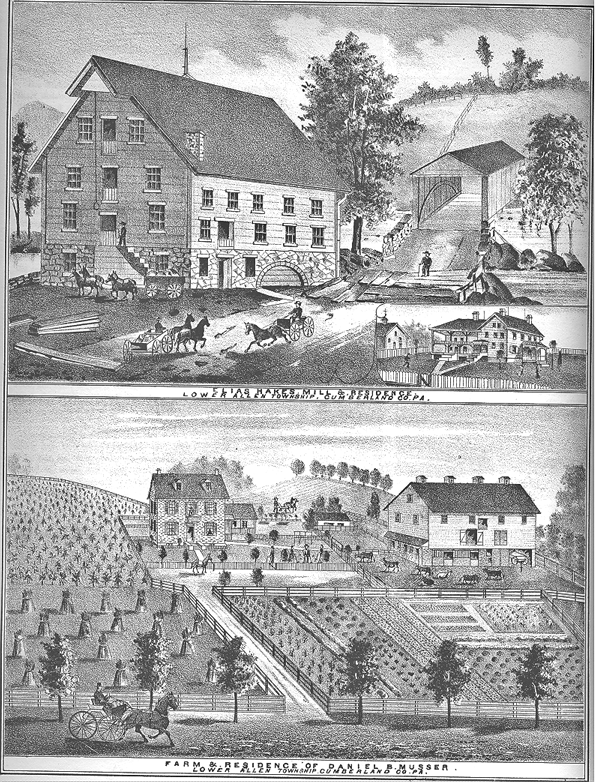
HISTORY OF CUMBERLAND COUNTY, PENNSYLVANIA - 203
Forty-four acres of the land were bought of " Benjamin Kurtz and Elizabeth, his wife," in 1811; to which was added in 1814, by purchase of "John Crist and Catharin, his wife," 26 acres.
The Susquehanna river bounds the town on the east and the Yellow Breeches creek on the south.
Mr. Haldeman came from Lancaster county eight years before. He bought the water power and forge at the mouth of the creek, and, having added a rolling and slitting mill, by his energy and industry he soon became one of the foremost iron manufacturers in the state, and rapidly laid the foundation for a princely fortune. His superior iron found a steady market for years for government purposes at Harper's Ferry.
He was largely the architect of his important improvements, and with his own hands frequently took hold of the huge tongs and taught the men to manage properly the rolling and slitting of iron. He was also fond of agriculture.
There was no bridge over the creek at New Cumberland then, and none over the river at Harrisburg. The Ferries were valuable property, and their owners usually made historic names.
All the children of this distinguished Haldeman family except Hon. Richard J., were born in the old family mansion, just where Christian Garver's house now stands.
New Cumberland has a history quite ancient. The Shawnee Indians who had located in 1689 upon the Conestoga flats soon removed to the west bank of the Susquehanna, occupying lands near the mouth of the Yellow Breeches creek, then called by the Indians " Callappus Kinck."
Its present name we notice as early as 1740. It is doubtless a corruption of Yellow Beeches, a large growth f which lined its banks near its mouth until recent years.
As late as 1730 these Shawnee towns occupied the river front near the mouths f the Conodoguinet and Yellow Breeches creeks.
Under a warrant and deed dated 1739, Peter Chartier, a French and Shawnee half-breed, owned all the land where New Cumberland stands. Mr. John Feeman has the original deed still in possession. It is signed by the three brothers, John, Richard and Wm. Penn. Chartier had a trading post of considerable importance here.
New Cumberland was at. first (1814) better known as " Haldeman's town." Lumber and coal were brought here in large quantities on rafts and arks, and supplied the counties of Cumberland, Franklin and Adams, the upper part of York county and much of Western Maryland. Flour. grain, iron and whiskey were received in large quantities and forwarded upon the river in arks to Port Deposit, then to Baltimore and Philadelphia.
After the large merchant mill was built by Mr. Haldeman in 1826 an important grain market was opened, buying most of the wheat far up the valley.
We have seen scores of great teams in the season here daily discharging their loads of grain and reloading with lumber ; some of which required an entire week to make the trip.
Previous to 1814 John Crist and Robert R. Church had a lumber yard just north of the town. John Poist, who built and kept the " White Tavern" on Market street, occupied the south bank of the creek with a similar business.
Mr. Crist died in 1832, and Mr. Church continued the business and built the warehouse, now the
steam saw mill.
He married a Miss Bigler, of the Harrisburg family of that name, a relative of ex-Governor Bigler. Of their children Henry Church was a popular member of the House of Representatives from Cumberland county at the time f his death. Mary, their fourth daughter, became the wife of Gov. Geary, and presided at the Executive Mansion during his term of office. Gov. Geary resided here from 1861 until his inauguration as Governor in January, 1867.
The Church family have long occupied a warm place in the memory and affections of the older inhabitants of New Cumberland.
Among the business men in the early history of New Cumberland was Alexander Officer, a tanner, noted for his superior leather.
For some 16 years the town had varying fortunes. At first the lots sold for $300. Ten or fifteen years later they sold at from twenty to thirty dollars. About 1830 it became more settled and prosperous.
In addition to the large saw mill erected by Messrs. Haldeman and George Crist, Philip Fittrow had built a chopping, oil and carding mill. Elijah and Charles Yocum had a carding machine factory ; and a " hand-made nail" factory was in operation.
Mr. Ephraim Fahnestock and William Boggs, Esq., (afterwards a prominent business man of Baltimore) were among those engaged in business here at this time.
In 1831 the town was incorporated a borough. Eighty years later the borough was made a separate election district.
In 1832 the mills of Mr. Fittrow were burned. A fire company came with an engine all the way from Harrisburg to the fire—the only fire engine ever seen in the town.
About this time the " York Haven and Harrisburg Bridge" turnpike road was built through the town ; and the daily stages made this a favorite route to Baltimore and Washington.
As early as 1826 a Sunday School was regularly organized, chiefly through the labors f Mrs. Haldeman and Mrs. Julia Culbertson. Mr. Robert Ralston, of Philadelphia, who sat with the father of Mr. Jacob M. Haldeman in the assembly at Philadelphia, sent a large trunk full of books and sunday school requisites, some of which still are preserved. Mrs. Haldeman sent to the Sunday School on the occasion of its semi-Centennial, which occurred in 1876, a library of elegant books, through the wife of her grandson, Andrew Ross, Esq., as a souvenir and memento f the long past. She may well feel proud of her work so nobly done for the Master more than half a century ago, for the school has not been closed in all those years.
Mrs. Culbertson was an accomplished and gifted lady, sister of Gen. Michael T. Simpson and mother of John and Wm. Culbertson, distinguished citizens of South Bend, Indiana; and Mrs. Snively, late of the same place where the remains of this aged saint sleep.
In 1816 Revs. Jacob Gruber and Richard Tidings, itinerant Methodist preachers, established an " appointment" in New Cumberland. In 1819 the society is noticed for the first time in the financial reports of the " circuit," reaching from York to Shippensburg and from Gettysburg to the Susquehanna river. The amount reported is $2.85 for the support of the preachers.
The first church was built in 1828, and had the usual hard struggle of all first churches with poverty. It was the only church in the town for over thirty years.
The present M. E. church was built in 1858. Rev. S. B. Dunlap was " preacher in charge."
In 1873 the " appointment" became a " station." Rev. P. F. Eyer was the first stationed preacher.
In 1873 the United Brethren built their church. These two are the only denominations having organizations here.
About 1873 Frederick J. Kramp came to New Cumberland. He
204 - HISTORY OF CUMBERLAND COUNTY, PENNSYLVANIA.
was intelligent and fond of Botany, Ornithology and Entomology' His collection of leaves, birds and bugs ffered great amusement and instruction to the children who often crowded the kind German's tailor shop.
Mr. Haldeman removed to Harrisburg in 1826, and the iron works fell into decay, being no longer profitable. He retained a large interest, however for twenty years longer, in the grain and lumber business conducted by George Crist. Mr. Crist did an extensive business, was a man of energy and had the good American quality of "pluck." He retired in 1848 and spent nearly thirty of his last years in Middletown, where he died during the present year.
New Cumberland was a political centre in 1840, and Samuel T. Williams printed a Whig campaign paper called " The Watchman." Log cabins, hard cider, coons and poles were plenty in the town. "The Watchman" did not long survive the campaign. Morgan, Fisher & Co. had a nail factory here at this time, which, however, was soon removed to Duncannon.
For several years following little of interest occurred. Thomas Orr obtained a contract to supply the Government works at Harper's Ferry with gun boxes, He hauled them all the way across the county on wagons.
Benjamin H. Mosser, Charles Oyster and George Crist were conducting the lumber business, which continued to grow in importance.
B. F. Lee and Sales J. Bowen were engaged in manufacturing patent pumps. On the election of Mr. Polk to the Presidency Mr. Bowen removed to Washington. He has held many important public offices and still resides there.
In 1846 Mr. Lee established the " Bucket Factory," which was successful, and employed a number of hands.
He engaged in the lumber businesss in 1851 with Henry Church and Adam Feeman as partners, and built the steam saw mill.
Mr. Lee entered the military service with Gen. Geary in 1861. When Gen. Geary was Governor he was appointed " Grain Measurer at Philadelphia," and was " Private Secretary" during the General's last term. He was " Indian Agent" for a short time during Grant's administration. He died in New Cumberland in 1877.
The York and Cumberland Railroad was opened for business in 1851. The lumber business was greatly stimulated for a time, but other trades did not share its prosperity. The long lines of teams gradually disappeared from the streets ; the cars carried away the lumber to distant points ; the hotels were no longer crowded, and many in the town and vicinity have since closed. What was lost in this line of business has been a gain to morality.
The Planing Mill was built in 1854, by Messrs. Stoever & Wise. It was bought in 1855, by B. II. Mosser & Co., and soon became an important industry. Its manufacture f doors, sash, &c., found a ready market in Baltimore, and they :were sent as far south as Pensacola and Cuba. The reputation of the Mill is well sustained under its present proprietors, Messrs. Shoop & Sadler.
Owen James was a member of the firm of B. H. Mosser & Co. For over twenty years he was in active business in New Cumberland. Ill health caused his retirement in 1864. Mr. James was a man likely to bring success to almost any business. He comes of patriot sires.
His grandfather was a soldier of the Revolution, and fought again in the War of 1812-14. Returning homeward from the " Canada frontier," at the close of the war, he was taken sick and died at Painted Past, in the Slate of New York, where his remains lie buried.
Mr. James commenced life by attending stone masons at 50 cents per day, of about twelve hours.
One season of this experience changed his tastes, and he soon found more congenial pursuits ; but he never forgot his early experience, and the poor laborer or struggling young mechanic was sure to find sympathy and a friend in Owen James.
The lumber business reached a high point of interest here in 1857, when seven firms were engaged in the trade. From this date there has been a gradual withdrawal, until but one firm is left in the business.
Gen. Geary removed his family here from Westmoreland county, in 1861, and remained until his inauguration as Governor in January, 1867.
The close proximity of Harrisburg prevented any large stores from being established in New Cumberland, and efforts in this direction were not successful until recently. In 1858, Theodore Willitt built a store room f good size with modern improvements. In 1868, Andrew Ross, Esq., built a store near the bridge, and in 1875, Mr. Henry Baughman erected another. In the early history f the town, John Campbell, Joseph Irvine, John Klein, Alfred Greason and Jacob Baxtresser had " stores" here.
In 1839, John G. Miller, Dr. Mateer, Dr. Asa White, and John Sourbeck were interested in mercantile pursuits. Later, Henry Brenneman, James K. Boak, W. S. Prowell, Jacob Swisher, Dr. Dehm, and others were similarly engaged. John G. Miller, Herman Long, Joseph Feeman, and Kline & Kauffman were at sundry dates engaged in storekeeping. At present, Mr. Joseph Baughman and Mr. Wm. H. Sible have the only stores.
New Cumberland now has 130 dwellings, 3 large Stores, 2 Hotels 1 Flour Mill, 2 Saw Mills, a large Planing Mill and Sash and Door Factory, a good School House and 2 good Churches with the usua, number of shops and small trades.
Schools have received considerable attention. Finely shaded grounds have been secured. Mr. James MacCarthy is teacher of the Grammar school, and John A. Sprenkle has charge of the primary.
A brief mention of some of our present citizens will close this sketch.
Rev. S. Milton Frost, D. D., is pastor of the M. E. church. Rev. John H. Young, the Presiding
Elder of Chambersburg District U. B. church, resides in the village.
Drs. Jacob W. Roop, Henry W. Linebaugh and Austin Best are resident physicians.
Our active business men at present are, Capt. S. J. Shoop, John L. Sadler, Joseph Baughman, Christian Garver, William H. Sible, Harry Wilt, Jesse Oren, Lea A. Nauss and Milton K. Brubaker.
Of the older citizens of the village, who have been prominently identified with its business, and arc now wholly or partially retired, are, Owen James, Rudolph Martin, John G. Miller, Henry R. Mosser, Adam Feernan, Lewis Young, Joseph Feeman, John Rife. William S. Prowell, Jacob Carpenter and John F. Lee, Esq.
Many of our citizens find steady employment at the Pennsylvania Steel Works, which are situated just opposite the village, and add much to the prosperity of the town. The workmen cross and recross the river day and night.
The Planing Mill, Sash and Door Factory employs quite a large number of hands, and the Railroad repair gang is sometimes quite large. All these are paid in cash regularly every month, and but few communities present so many evidences of comfort, and so few ob jects f distress and want.
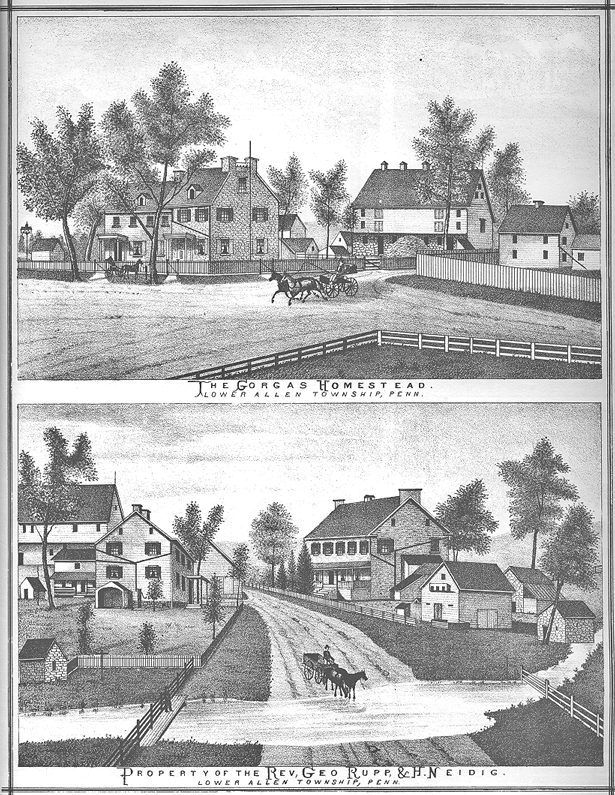
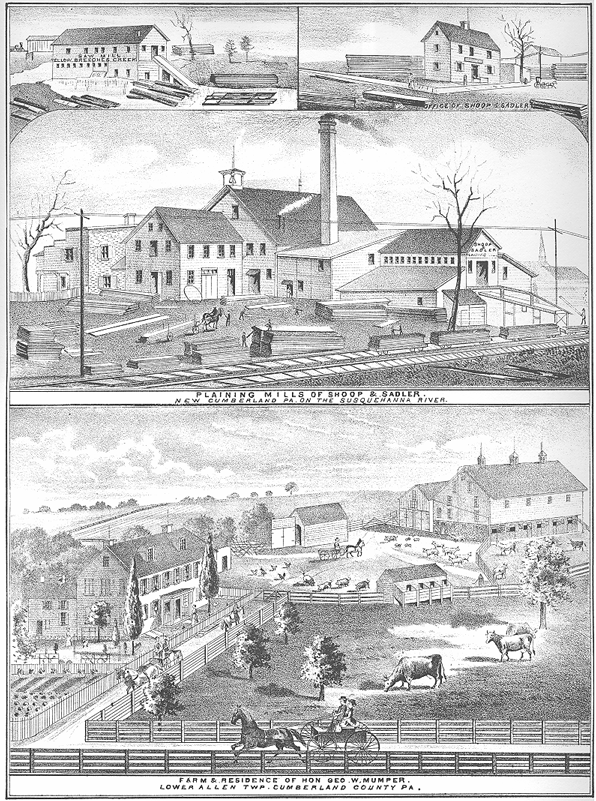

HISTORY OF CUMBERLAND COUNTY, PENNSYLVANIA - 205
Comfortable homes are being built each year through all these trying times ; and with coming prosperity, we hope for the fulfillment of the founder's expectation, " that New Cumberland would yet be u large and prosperous town."
SHIREMANSTOWN.
BY DANIEL RUPP.
Shiremanstown is situated in the eastern part of Cumberland county five miles west of Harrisburg on the Simpson's ferry road leading from Harrisburg to Carlisle, in the very heart of the great Cumberland Valley, and has a population of about 500 inhabitants. The Cumberland Valley Railroad runs close by the town on the north side. It was incorporated in the year 1875, and was named after Mr. Daniel Shireman, one of the first residents of the town, who owned the land on which a part of the town is built, and was engaged in hotel-keeping, merchandising and farming.
The first house was built by John Davis about 1812 or 1814, and is now owned and occupied by Rev. Jacob Erb. It was used as a hotel, and afterwards as a store, the earliest in town and kept by Joseph Stroh.
Among the other buildings are : The house now owned and occupied by Benjamin Longnecker, at first used as a hotel, but afterwards as a tailor shop and private alley.
The house now owned and occupied by Mr. Henry Zearing, who has lived longest in the town. and is now engaged as an agent for several Fire Insurance Companies ;
The house owned by Derrick Fahnestock and occupied by Thomas McGuire ;
The house now owned and occupied by Mr. M. P. Dill.
The borough has a brick school house two stories high, built in 1868, by Lower Allen township before the borough was incorporated.
There are three houses of worship in the borough. The first was a frame building, one-story high, built in 1838 as a union house, but a few years since it was enlarged and remodeled by the Church of God. The congregation which worships in it, has for its present pastor the Rev. A. A. Wiley.
The next house of worship was built in 1854 by the United Brethren in Christ. It is two stories high, the first story being built of limestone and the upper story of brick. J. P. Anthony is the pastor.
The next house of worship was built in 1867 by the Messiah's church. It was built f brick two stories high, and is the finest church building in the town. The seats and doors are made f chestnut which has been oiled and varnished. Its bell is the oldest in the country, having been cast in the year 1787. Martin Stutzman is the pastor.
The following persons are engaged in merchandising : John M. Templin, H. M. Rupp and Jacob Rupp (doing business as the firm of H. M. & I. Rupp), and D. S. Mohler and Daniel Bowman (doing business as the firm of Mohler & Bowman.) In the grain and coal business are Jacob R. Miller occupying the warehouse erected by Jacob and Henry Rupp in 1838 and enlarged by Christian Eberly in 1876 ; and John S. Rupp occupying the warehouse erected by Mrs. Mary Rupp, widow f Henry Rupp, dec'd., in 1873.
UPPER ALLEN.
BY HENRY S. MOHLER.
Upper Allen is bounded on the north by Hampden township, on the east by Lower Allen, on the south by the Yellow Breeches creek* and on the west by Monroe township. The earliest settlers were Scotch-Irish, principally from Lancaster county. They were the Pattersons, on land now owned and occupied by Moses C. Eberly ; the Grahams who settled where James Graham now lives ; the Quigleys, on a farm in the possession of Josiah Nelson ; the Wertzes on a farm now owned by Milton Stayman ; the Dunlaps on land at present owned by Mrs. Coover, on the Lisburn road ; the Coovers, originally from Switzerland, on a place in the possession of their descendants ; and the Mohlers on lands still held by the family. This family originated in Germany and settled in Lancaster county. In 1800 Daniel Mohler and his uncle, Christian Mohler, came to this valley and purchased several large tracts of land which have since become very valuable. The " Spring Dale " farm has been in the possession of the
* The Indian name of this creek was Caliposink, signifying " turnirg back," the creek being very crooked. It was afterwards called Yellow Breeches, a corruption of " Yellow Beeches," a name given on account of the yellow pebbles found abundantly along its shore;.
206 - HISTORY OF CUMBERLAND COUNTY, PENNSYLVANIA.
Cocklin family for 106 years. It was purchased from the Penns in 1742 by Andrew Miller, who sold it in 1772 to Jacob Cocklin, the great-grandfather of Henry M. Cocklin, the present owner. There are four large springs of limestone water on the property, which is now divided into two farms. Jacob Cocklin came in 1733 from the western part of Germany, and settled first in Lancaster, but afterwards in Cumberland county. Michael, his grandson, and the father of Henry M., was born in 1795, and died in 1878, having lived and died on the farm where he was born. Though retiring in his disposition and disinclined to the bustle of public life, he was elected by his fellow citizens a member of the Assembly, and sat during the sessions of 1832 to 1834. At the conclusion of his term he retired again to his agricultural pursuits, but was once more called into the public service in 1856 as an Associate Judge, and continued in that office for ten years. He died in the 84th year of his age.
BUILDINGS.
The oldest buildings are a log house and barn on the farm belonging to the Garrett heirs. They are supposed to be not less than 125 years old. On this farm, fifty years ago, there were over two hundred cherry trees, under which, in the season, used to be celebrated what was called " cherry fairs," when " cherry bounce " circulated freely, and when the owner derived from the sale of his fruit more profit than from his crops of grain. The first stone house in the township was on the farm now owned by H. G. Moser, but it has since been replaced by a more imposing structure of brick. The first stone house which is still in use was built on the farm now owned by Joseph Bosler, near the close of the Revolutionary war. Another was built in 1790, on the farm of H. M. Cocklin. The first stone barn was built in 1801, on J. W. Byer's farm, and the first of brick was in 1812, on the farm of Jacob Gehr, near Lisburn, and was struck by lightning and consumed with all its contents in 1837.
VILLAGES.
The first place distinguished by the name of a village or town was called Stumpstown, but it never had more than five houses, and in 1810 was favored with a store, which, however, has been abandoned. Shepherdstown received its name from William Shepherd, but its first settler was a widow named McFall. In 1822 a store was opened there by Joseph Bowseman, but it has passed through various hands until in 1871 it came into the possession of its present owners, H. H. Lamb & Co. In 1873 it was burned with all its contents, but it was immediately rebuilt of brick. In 1875 Samuel Coover, the present post-master built a large shoe store opposite the hotel. In 1867 a town was commenced on the main road from Shepherdstown to Mechanicsburg, and a half a mile from the latter place, and was called Kohlerstown from the family by which it was originally settled. Another town has been called Bowmansdale from Jacob Bowman, a former sheriff of Cumberland county, and the principal proprietor there. It is the terminus of the Harrisburg & Potomac railroad, and promises to become a thriving place of trade. It has a store, two lumber and coal yards, a grist mill and a carpenter shop. A warehouse has also been erected but is now used as a church.
MILLS.
There are four flouring mills and one clover mill, all, with one exception, on the Yellow Breeches creek. The first mill was built of lob and was owned. by Richard Peters until 1746, since which time it has frequently changed hands, and is now owned by Levi Lantz. The old mill was torn down and rebuilt when in the hands of Matthias Sholl, and again rebuilt by the present owner, and is now one of the largest mills in the township. It is built f brick and runs four sets of burrs ; for power the Johnson wheel is used. The farm on which this mill is located contains 295 acres, and including mill, was once purchased by John Anderson from Richard Peters for £50. A saw and plaster mill once existed, but is now abandoned, on the farm now owned by Jacob Bishop. A clover mill is located on the same farm which was once (before 1817) used as a distillery, afterwards as a scythe and sickle factory, but finally (1820) converted to its present use. Hertzler's Mill is in the southwestern part of the township, has passed through many hands, has been rebuilt a number of times, and is now second to no other in the township, either in the number f its sets of burrs or in its water-power. On the farm now owned by Jacob Grissinger, was once a mill for manufacturing linseed oil, for breaking hemp and for carding wool ; but scarcely a trace f it now remains. A mill, long known (104 years) as Roseberry's Mill, has been in existence on the farm owned by the Brougher heirs, but for some years it has not been in operation. Underwood's Mill, two miles east of Shepherdstown, was purchased from Richard Peters, between 1740 and 1750, by Frederick Switzer, who joined the army and was absent during the Revolutionary war, and bequeathed it to his son, from whom it passed through many hands until it came into the possession of the present owner, Mrs. J. M. Underwood. It is located on a little stream which rises near Shepherdstown. Long's mill, at Bowmansdale, was before 1818 owned by Henry Quigley, but it is now in the possession f Dr. P. H. Long. In 1818 Mr. V. Gribble purchased of Mr. Cocklin about six acres of land on the Yellow Breeches with the view of establishing there a woollen mill. It was at first confined to the carding of wool into rolls, and the fulling of woolen cloths, but in time it assumed larger proportions. During the late civil war the business became less profitable, and it has been turned to the manufacture of carpets, under the name of the " Glenwood Mills." The whole business of raising wool, once so extensive in this region, has been of late years given up, and the few farmers who still pay attention to sheep raising find their profit principally in supplying the growing demand for mutton.
CHURCHES, MINISTERS, GRAVEYARDS, &C., &C.
The oldest church in the township is situated on the Lisburn road, on the farm of H. M. Cocklin, and known as the " Western Union Church." It was built in 1835, but the graveyard connected with it has been used for more than a hundred years. Another Union church was built in 1844 at the eastern end of Shepherdstown, and for some years was connected also with school purposes. The Reformed Mennonites, as we have seen (p. 130) in 1851, built a church on Winding Hill,* a mile and a half east of Shepherdstown on the State road on a farm belonging to Eli Yost. In 1861 a large church called the " Mohler Meeting House" was built by the German Baptists (p. 129), 70 by 40 feet, with a basement used for preaching and the
So called because the road which crosses it pursues a winding course to overcome the steepness of its sides.

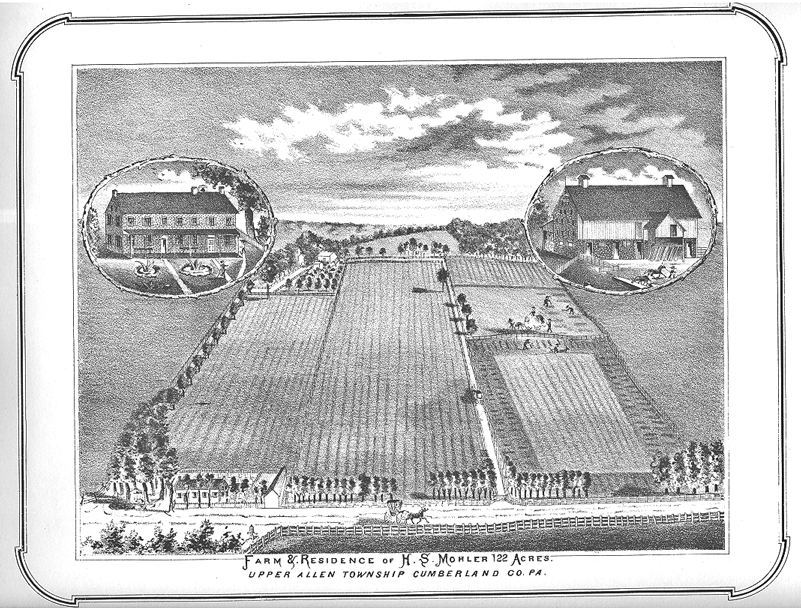
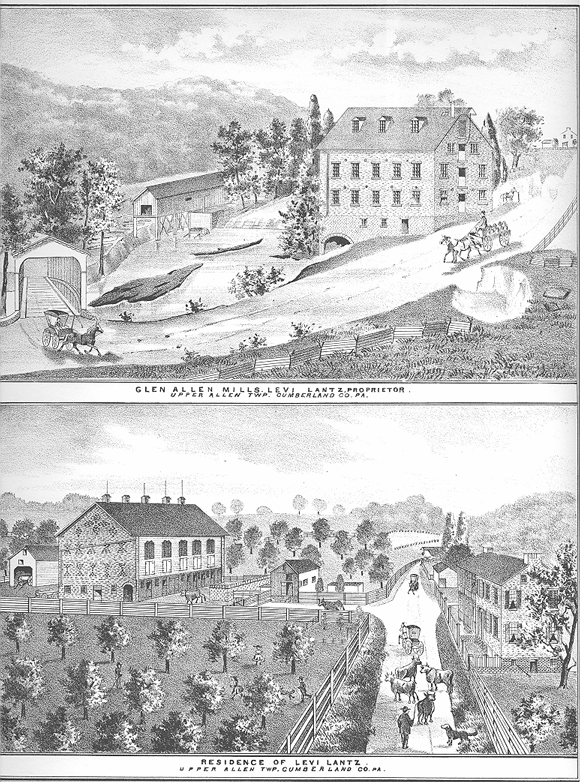
HISTORY OF CUMBERLAND COUNTY, PENNSYLVANIA - 207
large annual " Love Feasts." On the farm of John Dunlap are the grounds which were long used by the Methodists for their campmeetings. As early as 1820 and onwards almost every year meetings of this kind were held here until 1862, when they were removed to other places. At his death 1858 John Dunlap bequeathed twenty acres of this grove to the Methodist E. Church for campmeeting purposes forever. The grounds are elevated, sloping toward the east, and with two wells of excellent water within twenty rods of each other, one of them slightly affected by sulphur. There are a number of graveyards in the township besides what have been mentioned ; the oldest of which is on the farm now owned by Henry Yost, and three private ones ; the first for the Zug family on the farm of Samuel Grist, the second for the Lantz and the third for the Mohler families. The Chestnut Hill Cemetery for the use of the people of Mechanicsburg and its vicinity is under the control of an association which was incorporated in 1852. The ministers who now reside in the township are Eli Yost, the pastor f the Reformed Mennonites, and Moses Miller of the German Baptists. The physicians are R. W. Ross and J. H. Boyer, both f Shepherdstown.
The water by which Mechanicsburg is supplied is drawn from a reservoir built in Upper Allen township, one mile from Shepherdstown and two and a half from Mechanicsburg. The Gas Works for lighting the town are also in Upper Allen. Both the Water and the Gas Companies were incorporated more than fourteen years since.
SCHOOLS, SCHOOL HOUSES AND SUNDAY SCHOOLS.
The first schools of which we have any knowledge were taught in private houses. The first building erected especially for school purposes was built before 1800 on the farm now owned by David Coover. It was of logs, was covered with thatched straw, seated with slabs and three legged stools, and furnished with no desks except one for the teacher. In 1805 was built a house on the same farm ; in 1809 another on the farm of John Beelman, near Shepherdstown ; and two years later another still on the farm now owned by Judge H. G. Moser, but now used as a store for farm implements.
There are at present nine school buildings in the township, of which eight are f brick or stone, and the whole are valued at not less than $10,000. The number of pupils in the township at the last report was 381.
As early as 1818 a Sunday School was started in a school house half a mile south of Shepherdstown under the superintendence of Jacob Kniesley, who supplied the books at his own expense. The next was opened in 1820 at Taylor's school house, one mile north of Shepherdstown, under the supervision of Rev. James Williamson, pastor of the church at Silvers' Spring, and after a brief suspension was revived by Rev. George Morris, pastor of the same church. After an existence of 15 years it was removed to Shepherdstown, where it is still flourishing. In the Bethel church on the farm of David Coover, one mile east of Shepherdstown, a Sunday School was commenced in 1835, which was kept up with general regularity until a few years since. Another was begun in 1837 at the Centre Square school house, one mile south of Shepherdstown, which was continued about ten years ; another in 1858 in the Graham school house, which continued two years ; another in 1874 at the Glen Allen school house, which is still in operation ; and still another in 1875 at Cedar Hill, which is flourishing. The minutes of these schools show a fair attendance of children of both sexes.
PRINTING OFFICE.
The only printing office in Upper Allen was established in 1831 near Shepherdstown by Joseph Bauman, from Ephrata, Lancaster county. It is still carried on by his son Isaac, with all modern improvements, and devoted to all kinds of job printing.
IRON MINES AND LIME.
In 1840 a mine of hematite ore was discovered on a farm now owned by Jacob 'Weaver's heirs, a little west of Shepherdstown. Over four hundred tons were taken out for the iron works at Boiling Springs, a thousand tons by Mr. Odley, and in 1848 twenty-five hundred tons for the Dauphin Furnace. Although the mine was not exhausted, it has been abandoned in consequence of several accidents. Bodies f the same kind of ore have been found one mile south of Shepherdstown, and large boulders containing much iron have been hauled to the Furnace at Boiling Springs from the fields in different parts, the farmers being glad to have them removed from their grounds. Rich deposits of magnetic ore were discovered in 1853 on several farms on the Yellow Breeches creek south of Shepherdstown, while men were digging the foundation for a barn. A shaft was sunk and the ore was found to increase in richness with its depth until at 33 feet it was almost pure iron. About 1400 tons were taken out and sold, but the price which it commanded was scarcely remunerative, and the works were given up. A shaft of 14 feet was also sunk by H. K. Enck with a similar result, but on account of the interference of water it had to be abandoned. Men who are experts in the business are confident that there are in those places inexhaustible bodies f the purest magnetic ore.
Upper Allen is without doubt the leading township in the county with respect to the burning of lime. Not less than 400,000 bushels are sold annually from about fifty kilns, which are kept in constant operation. The largest part of this is purchased and hauled away by farmers in York and Adams counties.
ROADS.
The first public road in the township was laid out from Bowmansdale on the Y. B. creek to Silvers' Spring ; and the second was from Lisburn to Carlisle, and is known as the " Lisburn Road." The third was the " State Road" leading from Harrisburg to Gettysburg, laid out in 1810. It met with much opposition at first, even from those who were appointed to locate it. They directed it over hills that were almost impassable, hoping thus to effect its abandonment; but its usefulness has since been so thoroughly demonstrated that these hills have been either graded or avoided. In 1856 a road was opened from Shepherdstown to Mechanicsburg, almost parallel with the one first mentioned above, and in some places within hailing distance from it. It was at first thought to be a useless freak f the originator, but few would now be in favor f its abandonment.
DISTILLERIES AND TAVERNS.
It is said there has been a time in the history of this township when a still could be found on almost every farm. At a period when both railroads and canals were unknown in this region, the farmers converted their grain into whiskey in order that it might be conveyed to market at the least possible expense of time and money. In this
208 - HISTORY OF CUMBERLAND COUNTY, PENNSYLVANIA.
shape it was taken to Baltimore or Philadelphia in great Pennsylvania wagons, which returned with dry goods, groce ries and hardware. From ten to twenty such teams would travel in company, and when night came they would encamp by the way and their drivers would find amusement with each other. Some of these are still alive and tell us many a tale of their adventures. No distilleries are now in operation in the township, though the remains of some are seen in several places.
The first tavern or grog shop in the township was kept by an Irishman before 1800, on the farm now owned by Wm. M. Watts. He was well patronized and his place was the scene f much disorder. The second was kept in 1800 by H. Quigley, at what is now called Bowmansdale, and was conducted on the same principles. Other taverns have been kept by Jacob Gehr in 1829 on the state road ; by the same owner in 1826 at the foot of Winding Hill ; in Shepherdstown by David Shaffer in 1835, though it has since often changed owners, and is the place where township elections and public meetings are held ; and another at the eastern end f the same town, in the third story of which is also a public hall for general use. In 1876 a large three story hotel was built in Bowmansdale by George Burns the present proprietor.
SOLDIERS IN THE LAST WAR.
Among the officers and soldiers who went into the army from this township, were two captains, John B. Landis and harry S. Mohler (by brevet) ; one first lieutenant, George S. Emig; two second lieutenants, George Merritt and John D. Coover ; three sergeants, Jacob Gantz, Henry C. Springer and David Landis ; one musician, David S. Mohler ; and fifty-seven privates.
MECHANICSBURG.
BY A. J. HAUCK.
LOCATION AND EARLY HISTORY.
The borough of Mechanicsburg, is situated on the Cumberland Valley Railroad, 8 miles west of Harrisburg, and 10 miles east of Carlisle the county seat. The settlement of the town commenced about the beginning of the present century. In the year 1805 not more than a half dozen straggling houses were to be seen, at which time the place was known as " Stoufferstown" or " Drytown." The first of these appellations was derived from Mr. Henry Stouffer, one of the first settlers, who owned considerable land and laid out a large number of town lots ; and the other originated from the extreme scarcity of water at times, particularly during the summer months.
The land upon which the town now stands was originally owned by John Eberly, Henry Ford, John Gusweiler, John Miller, Jonathan Reese, Martin Rupp, George Stonespring, Henry Stouffer, Lewis Zearing, and probably one or two others. The descendants of these early settlers are now living in the place and vicinity, though some of the names have entirely died out. In 1820 the number of houses was about twenty-five or thirty.
INCORPORATION AND GROWTH.
The act of incorporation as a borough was passed by the Legislature April 28th, 1828, in pursuance of which an election for the borough officers was held on the 16th of May following, which resulted as follows : Burgess—Henry Ford ; Town Council—John Coover, Michael Hoover, Jacob Slyder, Lewis Zearing ; Overseers of the Poor—Jonathan Reese, Michael Weaver ; Supervisors—Christian Poorman, George Singiser ; Constable—Allison Pinney.
GROWTH AND IMPROVEMENT.
Prof. D. Rupp, in his history of Cumberland county, says : " In 1829, 1830 and 1831, between twenty and thirty houses were put up. In December, 1831, Major Henry Leas and David Brenizer, having purchased eight or ten acres from George Stonespring, laid out thirty-three lots on the south side of Main street. From that time forward the town has gradually increased, till it numbers at present (1845) 133 comfortable dwellings, whereof 41 are of brick, 67 frame, and 25 plastered ; a number of mechanics' shops ; four churches, viz : a Union. church, Methodist, Lutheran, and another styled a ' Union Bethel ;' a commodious schoolhouse, in which three public schools are taught ; 6 country stores, 2 apothecaries, 3 taverns, 3 ware or storehouses on the railroad, 4 tailor shops, 2 milliners, 3 dressmakers, 2 hatters, 4 shoemakers, 3 saddlers, 4 cabinetmakers, 4 carpenters, 3 weavers, 1 silk dyer, 2 tinners, 2 chairmakers, 1 painter, 1 cooper, 2 coachmakers, 3 blacksmiths, 3 butchers, 1 foundry and machine shop, and a population rising of 800."
For the next eight years the town seems to have had no very marked increase or improvement ; but from the year 1853 to the breaking out of the war in 1861, considerable progress was made, both in population and in the erection of many handsome public and private buildings. During this interval several new churches were erected, Cumberland Valley Institute and Irving Female College were built, two or three forwarding grouses, a new town hall and engine house, and a large number of dwelling houses were put up, all adding greatly to the appearance and prosperity of the borough.
During the first few years of the war, the unsettled condition of national affairs arid the high prices of labor and materials, retarded somewhat the march of improvement. But as soon as the success of the Union arms was assured, and peace once more was attained, business interests revived, and the invigorating effect was plainly visible in every branch of trade. Mechanics, artisans and laborers were in great demand ; houses sprang up as if by magic ; new societies and associations were organized ; the corporation limits were largely ex-
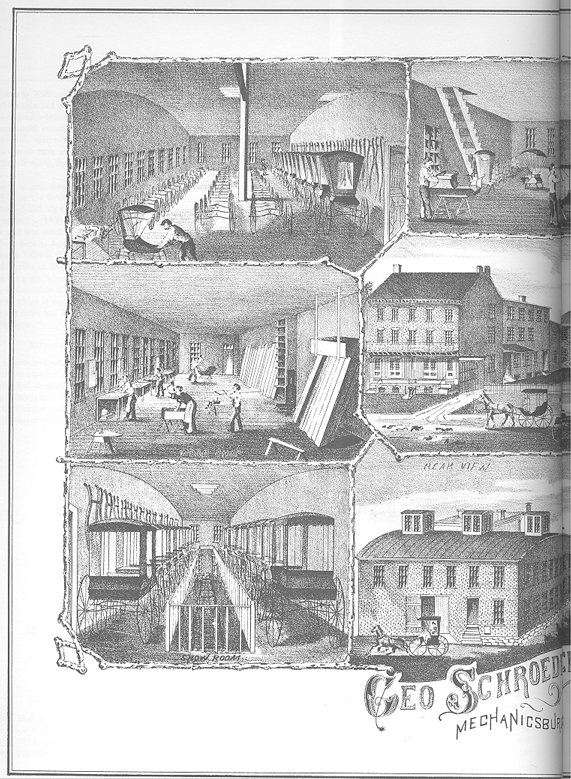
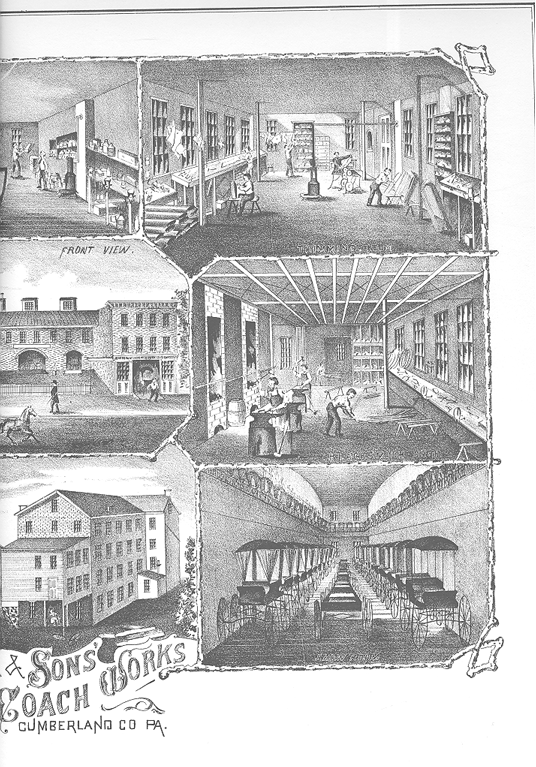
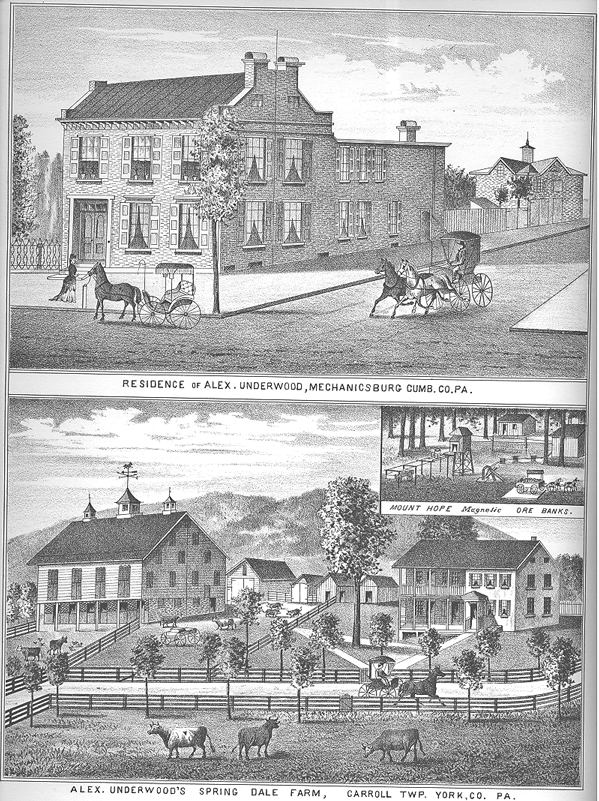
HISTORY OF CUMBERLAND COUNTY, PENNSYLVANIA - 209
tended, and never before or since did the town experience such a season of prosperity. In one summer not less than one hundred and twenty houses were erected, mostly by men of moderate means. It was during this period that the town was divided into two wards—North and South. But this era of improvement was destined to be of comparatively short duration, and was followed by a general stagnation in business. In fact, the town had evidently grown too rapidly. A number f business failures ocurred, and many workingmen were compelled to remove to other places in order to obtain a livelihood. This state of things continued for several years, after which the town began gradually to recover its former activity, when the monetary panic of 1873 came. Although not directly affected by the failures which originated this panic, Mechanicsburg could not hope to escape the disastrous results caused by the almost universal suspension of the iron manufacturing interests of our state; yet with all these outside influences to contend against, it is a matter of congratulation that our town has weathered the financial storm so successfully, and has increased considerably in population during the past five years, besides erecting a large number of new buildings for dwellings and business purposes.
POPULATION.
The figures given below—with the exception f those for 1876, are taken from the official census reports of the United States.

